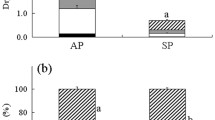Abstract
Different disturbance regimes in aquatic habitats may bring about life-history differentiation in aquatic plants. However, there is little information on this association. Adult longevity, seed size and mass, and seed-germination characteristics were surveyed for Nymphoides coreana populations, which grow in different types of aquatic habitats, to demonstrate life-history differentiation. Seed size and seed mass were significantly greater in paddy-field populations (disturbed habitats) than in irrigation-pond populations (stable habitats). Paddy-field populations were composed of annuals, whereas irrigation-pond populations contained perennials. Seed-germination characteristics were significantly different between paddy-field and irrigation-pond populations. The moist-chilling pretreatment period needed to release innate seeds from dormancy was significantly shorter in paddy-field populations than in irrigation-pond populations. The percentage of seeds that germinated was significantly higher under anaerobic conditions, irrespective of light, and under light aerobic conditions compared to dark aerobic conditions in paddy-field populations. Conversely, in irrigation-pond populations, the percentage of seeds that germinated was highest under light anaerobic conditions. These results show that the reaction norm of seed-germination characteristics was significantly broader in annual populations than in perennial populations. The occurrence of aquatic habitats with different disturbance regimes thus contributes to the maintenance of phenotypic diversity in N. coreana populations.

Similar content being viewed by others
References
Arendt JD (1997) Adaptive intrinsic growth rates: an integration across taxa. Q Rev Biol 72:149–177
Baker HG (1955) Self-compatibility and establishment after “long-distance” dispersal. Evolution 9:347–349
Barbier P (1989) Genetic variation and ecotypic differentiation in the wild rice species Oryza rufipogon. I. Population differentiation in life-history traits and isozymic loci. Jpn J Genet 64:259–271
Baskin CC, Baskin JM (1998) Seeds: ecology, biogeography, and evolution of dormancy and germination. Academic, San Diego
Begon M, Harper JL, Townsend CR (1996) Life-history variation. In: Begon M, Harper JL, Townsend CR (eds) Ecology. Individuals, populations and communities, 3rd edn. Blackwell Science, Oxford, pp 526–566
Christensen NL (1985) Shrubland fire regimes and their evolutionary consequences. In: Pickett STA, White PS (eds) The ecology of natural disturbance and patch dynamics. Academic, San Diego, pp 85–100
Dorken ME, Barrett SCH (2003) Life-history differentiation and the maintenance of monoecy and dioecy in Sagittaria latifolia (Alismataceae). Evolution 57:1973–1988
Downs MP, Cavers PB (2000) Effects of wetting and drying on seed germination and seedling emergence of bull thistle, Cirsium vulgare (Savi) Ten. Can J Bot 78:1545–1551
Environment Agency of Japan (2000) Threatened wildlife of Japan: red data book, vol 8: vascular plants, 2nd edn. Japan Wildlife Research Center, Tokyo (in Japanese)
Fukao T, Kennedy RA, Yamasue Y, Rumpho ME (2003) Genetic and biochemical analysis of anaerobically-induced enzymes during seed germination of Echinochloa crus-galli varieties tolerant and intolerant of anoxia. J Exp Bot 54:1421–1429
Grime JP (1979) Regenerative strategies. In: Grime JP (ed) Plant strategies and vegetation processes. Wiley, Chichester, pp 79–119
Kadono Y (1994) Aquatic plants of Japan. Bun-ichi Sogo Shuppan, Tokyo (in Japanese)
Kobayashi H (1984) Life-history of an aquatic weed, Eleocharis kugoguwai Ohwi. In: Kawano S (ed) Life-history and evolution of plants, vol 1. Baifu-kan, Tokyo, pp 101–122 (in Japanese)
Matsumura M (1967) Genecological studies on the foxtail grass, Alopecurus aequalis, in Japan, vol 25 (Research Reports of the Faculty of Agriculture). Gifu University, Gifu, pp 129–208 (in Japanese with English abstract)
Ministry of Agriculture, Forestry, Fisheries (1998) Biodiversity in agro-ecosystems. Youkendo, Tokyo (in Japanese)
Morishima H, Sano Y, Oka H-I (1992) Evolutionary studies in cultivated rice and its wild relatives. In: Futuyma D, Antonovics J (eds) Oxford surveys in evolutionary biology, vol 8. Oxford University Press, New York, pp 135–184
Oh MJ, Na HR, Choi H-K, Liu JR, Kim SW (2010) High frequency plant regeneration system for Nymphoides coreana via somatic embryogenesis from zygotic embryo-derived embryogenic cell suspension cultures. Plant Biotechnol Rep 4:125–128
Prati D, Schmid B (2000) Genetic differentiation of life-history traits within populations of the clonal plant Ranunculus reptans. Oikos 90:442–456
Sculthorpe CD (1967) The biology of aquatic vascular plants. Edward Arnold, London
Shibayama Y, Kadono Y (2008) Genetic variations in the endangered aquatic plant Nymphoides coreana (Menyanthaceae) in south-western Japan. Plant Species Biol 23:212–216
Simons AM (2007) Selection for increased allocation to offspring number under environmental unpredictability. J Evol Biol 20:813–817
Sokal RR, Rohlf FJ (1995) Biometry, 3rd edn. WH Freeman and Co., New York
Stearns SC (1992) The evolution of life histories. Oxford University Press, New York
Stebbins GL (1957) Self-fertilization and population variability in the higher plants. Am Nat 91:337–354
Ting-nung H, Ornduff R (1995) Menyanthaceae. In: Flora of China editorial committee (eds) Flora of China, vol 16. Science Press/Missouri Botanical Garden Press, Beijing/St. Louis, pp 140–142
Ueda Y (2003) Reproductive ecology of Nymphoides coreana (H. Lév.) Hara (Menyathaceae) (Masters thesis). Kobe University, Kobe (in Japanese)
Yamasue Y (2001) Adaptive physiology of weedy Echinochloa. Germination physiology of seeds and water physiology of seedling plants. In: Yabuno T, Yamaguchi H (eds) Plants of Echinochloa. Zennokyo, Tokyo, pp 69–78 (in Japanese)
Acknowledgments
I would like to thank Dr. Yasuro Kadono, who provided the opportunity for this study to be conducted. I am also grateful to Dr. Jun Nishihiro for valuable comments on the manuscript. Part of this study was supported by the Nippon Insurance Foundation.
Author information
Authors and Affiliations
Corresponding author
Additional information
Handling Editor: Takashi Asaeda.
Rights and permissions
About this article
Cite this article
Shibayama, Y. Life-history differentiation in Nymphoides coreana (Menyanthaceae) populations in aquatic habitats with different disturbance regimes in Japan. Limnology 13, 199–205 (2012). https://doi.org/10.1007/s10201-011-0368-y
Received:
Accepted:
Published:
Issue Date:
DOI: https://doi.org/10.1007/s10201-011-0368-y




